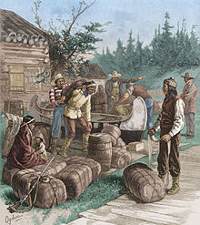The Hudson's Bay Company
The Hudson's Bay Company was at one point the largest fur company in North America. The company was named after English explorer Henry Hudson who sailed through the Canadian northeast in 1609–1610 and discovered the bay and river that were named for him. French explorers Pierre-Esprit Radisson and Médard des Groseilliers (who were brothers-in-law) ranged through the Canadian interior and discovered a rich potential for a fur trade. They approached British officials in Boston with a plan to plot their own course in the fur trade. A number of English officials sailed with the French pair to England, where a bunch of wealthy merchants formed the Hudson's Bay Company, in 1670. 
King Charles II granted the company a monopoly for all lands drained by the rivers that flowed into Hudson Bay. The date of incorporation of the Governor and Company of Adventurers of England Trading into Hudson's Bay was May 2, 1670. The first of a growing series of trading posts was Moose Factory, in the southern hub of James Bay, in 1673. More construction followed, including Albany Fort in 1674, Severn House in 1680, and York Factory in 1684. 
Each of the posts had a trader and a council of officers, who directed the economic proceedings. Members of Native American tribes would bring fur to the Hudson's Bay Company forts and get in return axes, knives, muskets, rifles, ammunition, glass beads, pottery, and other staples. One well-known feature of Hudson's Bay Company trading was the famous pointed white blankets. Each of the three pointed ends had a wide colored stripe–green, red, or yellow. These blankets had great value to Native Americans. France and Great Britain had engaged in spirit competition in the North American fur trade for many years. In 1713, British Queen Anne and France's King Louis XIV had signed the Treaty of Utrecht, aimed at sorting things out to a certain degree. Among the terms of that treaty was a provision that gave the Hudson's Bay Company sole trading rights in the Hudson Bay area and in the surrounding area, then called Rupert's Land (named after ; in return, Britain agreed to recognize French claims for sole trading rights on the St. Lawrence River and in the lands drained by the Mississippi River. These provisions looked good on paper but proved difficult to enforce in the wilds of what is now Canada. As well, four forts on Hudson Bay and James Bay were front and center in the armed struggle for supremacy in the surrounding area. France and Great Britain agreed to the Treaty of Ryswick in 1697, and that allowed the Hudson's Bay Company to avoid going out of business. The two countries eventually went to war, in a struggle that in North America was called the French and Indian War. The British victory in this war eliminated the official French presence in Canada. 
A group of French and Scottish traders formed a competing effort, the North West Company, in Montreal in 1779. The "Norwesters," as the new company's traders were known, followed paths west, down the Winnipeg River to lake Winnipeg and then into the Far West. The Hudson's Bay Company monopoly in Rupert's Land was technically still in effect; however, as before, it proved difficult to enforce in practice. The North West Company grew and grew, taking market share away from the Hudson's Bay Company. The HBC introduced the York boat as a replacement for canoes. Each of the new boats could carry more than three tons of goods, compared to the one-ton capacity of a canoe. As the new century dawned, it was the North West Company that began to struggle. The competition between the two rivals ended in 1821, when the British government forcibly merged the two companies, creating an enterprise that spanned the entirety of Canada. As a result, HBC's total of 68 trading posts and the North West Company's total of 107 trading posts became a total of 52, as many of the posts were closed because they were seen as unnecessary. The HBC expanded into Northern California and was eventually so powerful that it issued its own paper money. However, as the 19th Century progressed, the company diversified, anticipating a drop in demand for furs. Trading continued but with less and less furs. The HBC added oil and gas to its retail repertoire in the 1920s and bought oil companies in later decades, then focused on department stores in the late 20th Century. |
|
Social Studies for Kids
copyright 2002–2025
David White




